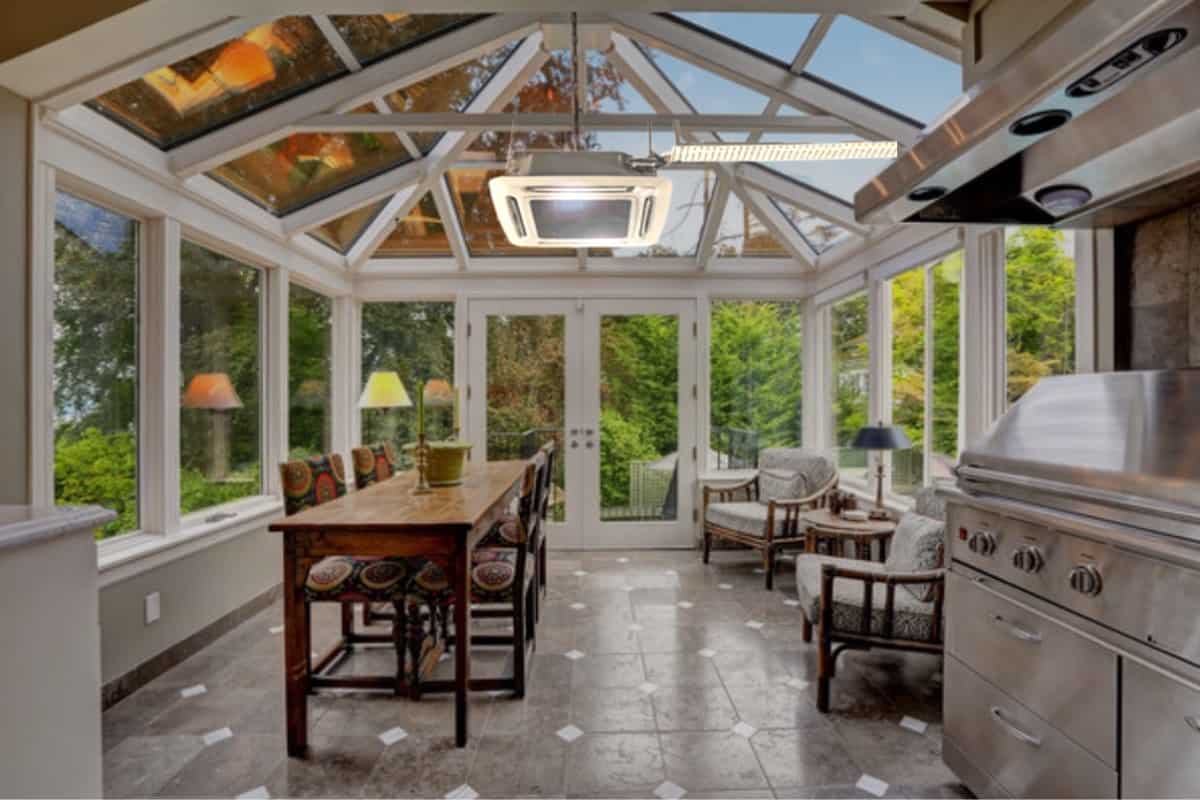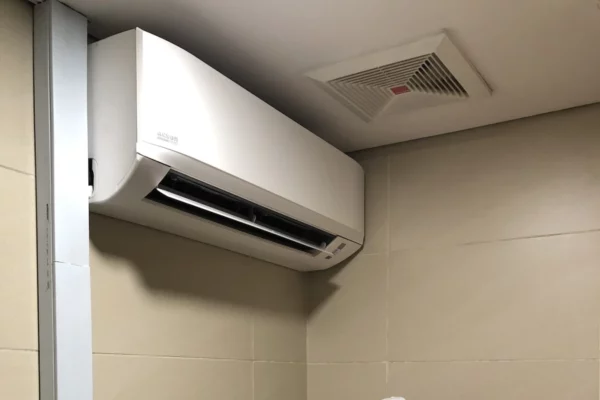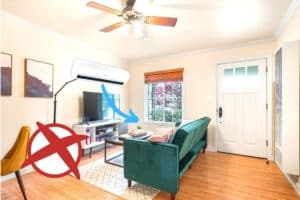Are Mini Splits Good for Sunrooms? (4 Benefits)
Sunrooms typically require a separate heating and cooling system. With mini splits being known for their high energy efficiency and quiet operation, are they good enough for sunrooms?
In short, mini splits are one of the best HVAC options for sunrooms. Mini splits operate more efficiently and quietly than other HVAC systems that fit in a sunroom. Besides, mini splits are available in several types which offer great installation flexible for any kinds of sunrooms.
Most people are not familiar with mini splits. Hence, they don’t realize the benefits a mini split can provide for their sunroom. Understanding the pros and cons of a mini split can help you make a more informed decision.
What is a Mini Split?
Mini splits are a kind of split air conditioning system. A mini split consists of one indoor unit (known as the evaporator) and one outdoor unit (known as the condenser). The two units are connected by refrigerant copper tubes and wires.
Nowadays, the indoor unit of mini splits have several types. The most common type is the wall-mounted type which is commonly known as the typical ductless mini split. It is an indoor unit that mounted at about 7-8 feet up high on the wall.
The wall-mounted type is the cheapest and most efficient among the mini split indoor units.
For sunrooms, there are two more kinds of mini split indoor units to choose from when the wall-mounted type is not possible (too many windows, no wall space to mount). They are the ceiling cassette type and the floor-mounted type.
Now, let’s compare mini splits to other sunroom HVAC options and see what’s the pros and cons.
4 Benefits of Mini Splits (in Sunroom)
Mini splits have their own advantages in general. To be more precise, let’s compare having a mini split in a sunroom versus having other HVAC systems.
1. Independent Heating and Cooling
Having a mini split in your sunroom means you’re not relying on your home HVAC system. This allows you to heat/cool your sunroom whenever it is necessary only, saving you the electricity cost.
Mini splits are controlled by a remote controller. You can set the room temperature, fan speed, airflow direction and even schedule the time to on/off the mini split. Nowadays, mini splits even come with WiFi connection which allows you to remotely control them via mobile app.
If you extend and use your home HVAC system to heat/cool your sunroom, you may find yourself constantly adjusting the thermostat because the heating load and cooling load in sunrooms are different from the rest of your house (when your house is comfortable, the sunroom is too hot, when the sunroom is comfortable, the rest of your house is either too cold or too hot).
With a mini split, you are able to handle the heating and cooling of the sunroom separately. It’s a win-win situation.
2. Quiet Operation
Mini splits are known for their incredible quiet operation. As mentioned earlier, a mini split comes with one indoor unit and one outdoor unit. The indoor unit is what mounting in your sunroom, the outdoor unit is typically installed outside your house at a few feet away from the indoor unit.
Hence, you only hear the fan noise from the indoor unit which is significantly quieter than PTAC, window air conditioners and portable air conditioners. These air conditioners are loud because their compressor (what’s make the loudest noise) is in the room.
Meanwhile, the compressor (outdoor unit) of a mini split is far away from the room. That’s why mini splits are so quiet. In fact, typical mini splits only produce about 20-30 dB of noise. They don’t cycle on/off and thus, don’t produce unpleasant noise.
3. High Energy Efficiency
When you add the indoor and outdoor units of a mini split, the total size is much bigger than PTAC, window air conditioners and portable air conditioners. However, it is on purpose.
Mini splits are much more energy efficient than other room air conditioners because they have a much greater contact surface area for efficient heat transfer. Furthermore, mini splits use inverter compressors which allow them to reduce power consumption when your room is sufficiently cooled/heated. Then, they continue running at low power to keep the room at a consistent temperature.
| Air Conditioner | Energy Efficiency Ratio (EER) |
|---|---|
| PTAC | 12 |
| Window AC | 12 |
| Portable AC | 10 |
| Mini Split | 16 |
Compare to other room air conditioners, mini splits are about 33-60% more energy efficient. In the long run, having a mini split in your sunroom can save you a significant amount of electricity cost.
4. Simple Installation
Mini splits are more difficult to install compare to PTAC, window air conditioners and portable air conditioners. However, they are still considered easy to install, especially when compared to upgrading and extending your home HVAC system.
Nowadays, many people install mini splits by themselves. All you need is to drill a 3″ hole on the wall for the refrigerant tubes, drain pipe and wires to go outside (to the outdoor unit). So, you can save money on the installation. The indoor unit just mount on the wall and the outdoor unit just sit on a bracket or plinth outside the house.
By the way, if you want to learn more about mini split especially how to design it for your house, consider my Mini Split (eBook). You’ll learn what is Mini Split, how to choose and more importantly, spark more design ideas to improve the energy efficient of your house. But, if you need a second opinion or want someone to help you design, then you can consider my consultation service.
Consultation Service
Ask me for HVAC advice such as brand selection, best model, benefits, features, placement, duct size, grille size, how to design, design check, verification and other HVAC related queries.
What Size Mini Split Do You Need for Sunroom?
A sunroom can gain an exceptionally large amount of solar heat during the day. Hence, sizing the cooling capacity of a mini split for a sunroom is very different from a typical bedroom or living room.
Generally, there are two types of sunrooms; a) 3-season and b) 4-season. 3-season sunrooms are built with poor insulation or no insulation at all. Meanwhile, 4-season sunrooms have good insulation.
Furthermore, there are 4 different types of sunroom structures as shown in the following:
- Conservatory – Full of windows including the roof in dome shape.
- Solarium – Full of windows including the sloping roof.
- Gable – Plenty of windows with a triangle-shaped roof.
- Shed/Studio – Plenty of windows with a sloping roof.
In short, conservatory and solarium have a glass roof while gable and shed/studio has a ceiling. Conservatory and solarium sunrooms have more effective cooling/heating space than gable and shed/studio sunrooms due to the high ceiling.
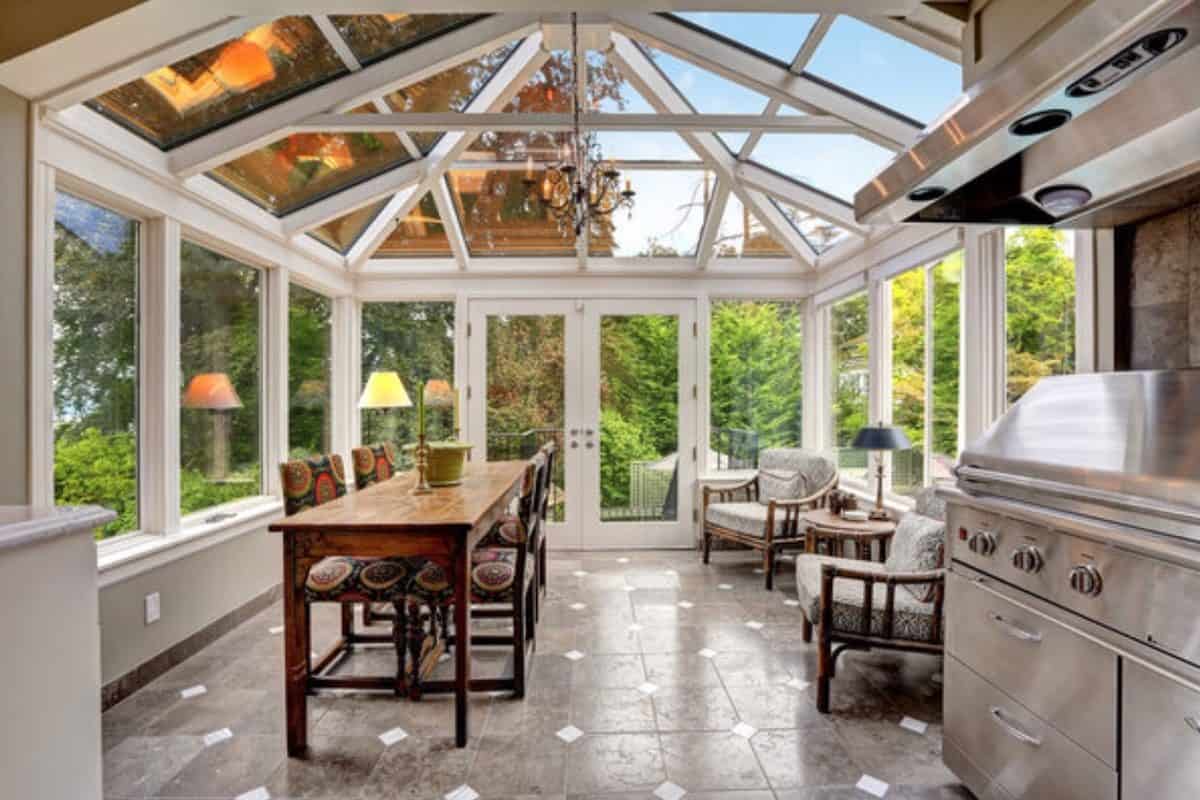
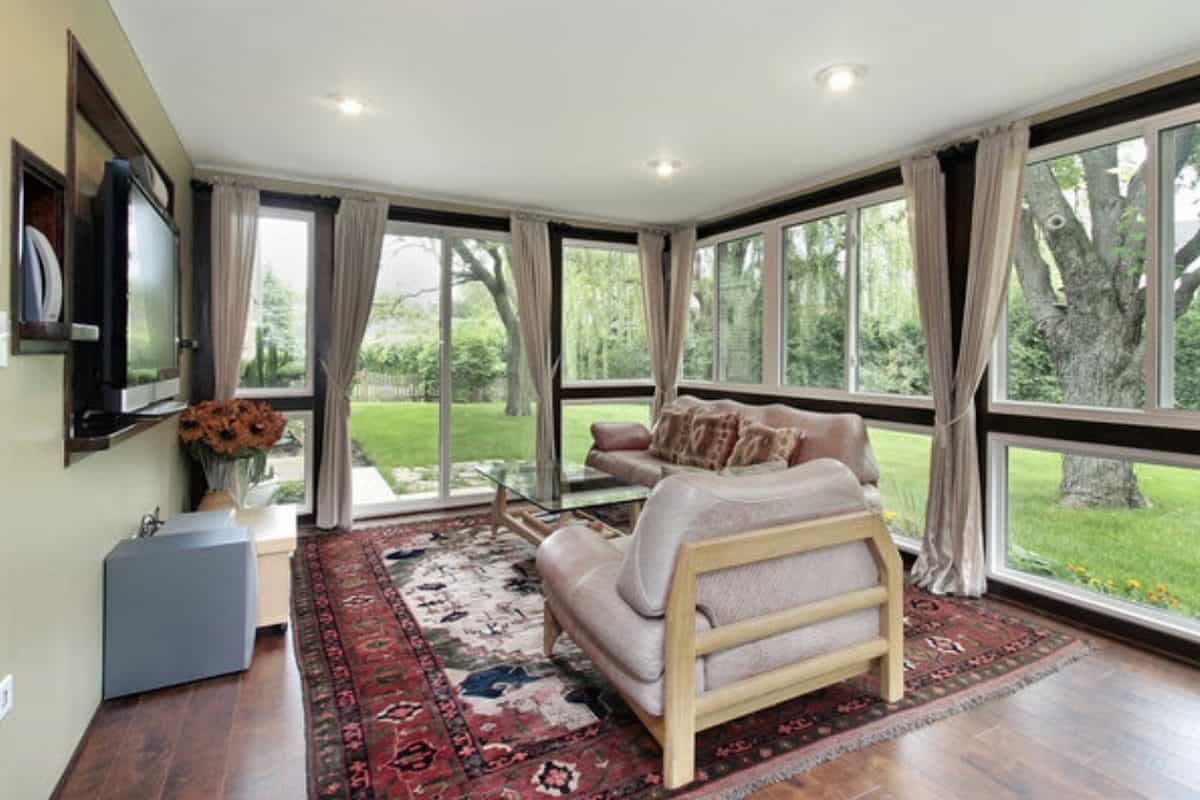
More windows mean more solar heat gain. Thus, a mini split must have sufficient capacity to handle the solar heat gain in order to provide sufficient cooling/heating to the sunroom. However, sunrooms with insulated glass and ceiling have less solar heat gain and hence, don’t need a large capacity mini split.
Mini Split Size for 3-Season Sunrooms
3-season sunrooms are built with poor insulation or no insulation at all. Hence, a bigger size mini split is needed to provide adequate cooling and heating.
Below is the estimated mini split size for different sunroom structures and floor areas:
| Sunroom Area | Conservatory & Solarium | Gable & Shed/Studio |
|---|---|---|
| 150 sqft | 9,000 BTU | 9,000 BTU |
| 200 sqft | 12,000 BTU | 9,000 BTU |
| 250 sqft | 15,000 BTU | 12,000 BTU |
| 300 sqft | 18,000 BTU | 18,000 BTU |
Mini Split Size for 4-Season Sunrooms
4-season sunrooms are built with good insulation. They are meant to be cooled and heated. So, a small size mini split is all they needed to provide adequate cooling and heating.
Below is the estimated mini split size for different sunroom structures and floor areas:
| Sunroom Area | Conservatory & Solarium | Gable & Shed/Studio |
|---|---|---|
| 150 sqft | 9,000 BTU | 9,000 BTU |
| 200 sqft | 9,000 BTU | 9,000 BTU |
| 250 sqft | 9,000 BTU | 9,000 BTU |
| 300 sqft | 9,000 BTU | 9,000 BTU |
Nonetheless, other factors such as sunroom orientation and windows quantity need to be considered. Hence, getting yourself a few local HVAC contractors for comparison is advisable.
If you’re looking to buy a mini split for your sunroom, don’t forget to check out my post on the best mini splits in 2023.
3 Types of Ductless Mini Splits for Sunroom
Most people know that the air handler of the ductless mini split is a wall-mounted type. So, if their sunroom is full of windows, they have no idea how to install a mini split in their sunroom.
However, there are 3 types of ductless mini splits suitable for a sunroom. Let’s take a look at how each type of mini split is installed in a sunroom.
1. Ceiling Cassette Mini Split
The best type of ductless mini split for sunrooms is a ceiling cassette type. It can be hung at the center of a sunroom and distribute air evenly throughout the sunroom.

To install a ceiling cassette mini split in a sunroom, the sunroom roof support must be strong enough to take on the weight of the ceiling cassette unit which is around 40 lb (18kg). A ceiling cassette unit needs 4 support points and hence, you may need to add two perpendicular beams.
The refrigerant and drain line as well as the power and control cables of the ceiling cassette unit can be hidden on perforated cable trunking and run on the ceiling level towards its outdoor unit.
It looks even better if your sunroom has a ceiling. The ceiling cassette unit will flush with the ceiling and all the pipes will be hidden above the ceiling.

So, if your sunroom is full of windows, you may consider installing a ceiling cassette type of ductless mini split heat pump. Not only it distributes air evenly, but it also maintains the aesthetics of your sunroom.
Many people are not familiar with ceiling cassette types of ductless mini split heat pumps. They can be hung with long rods from supports such as wooden beams and soffit slabs.
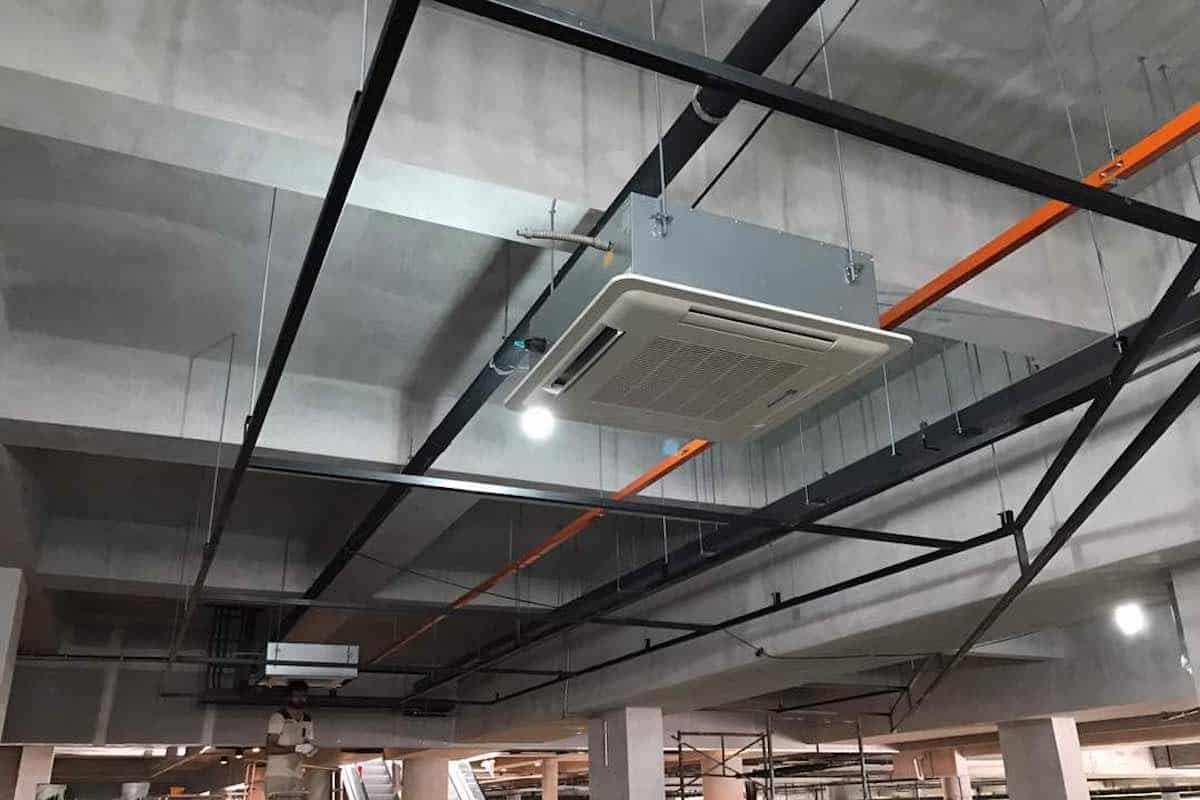
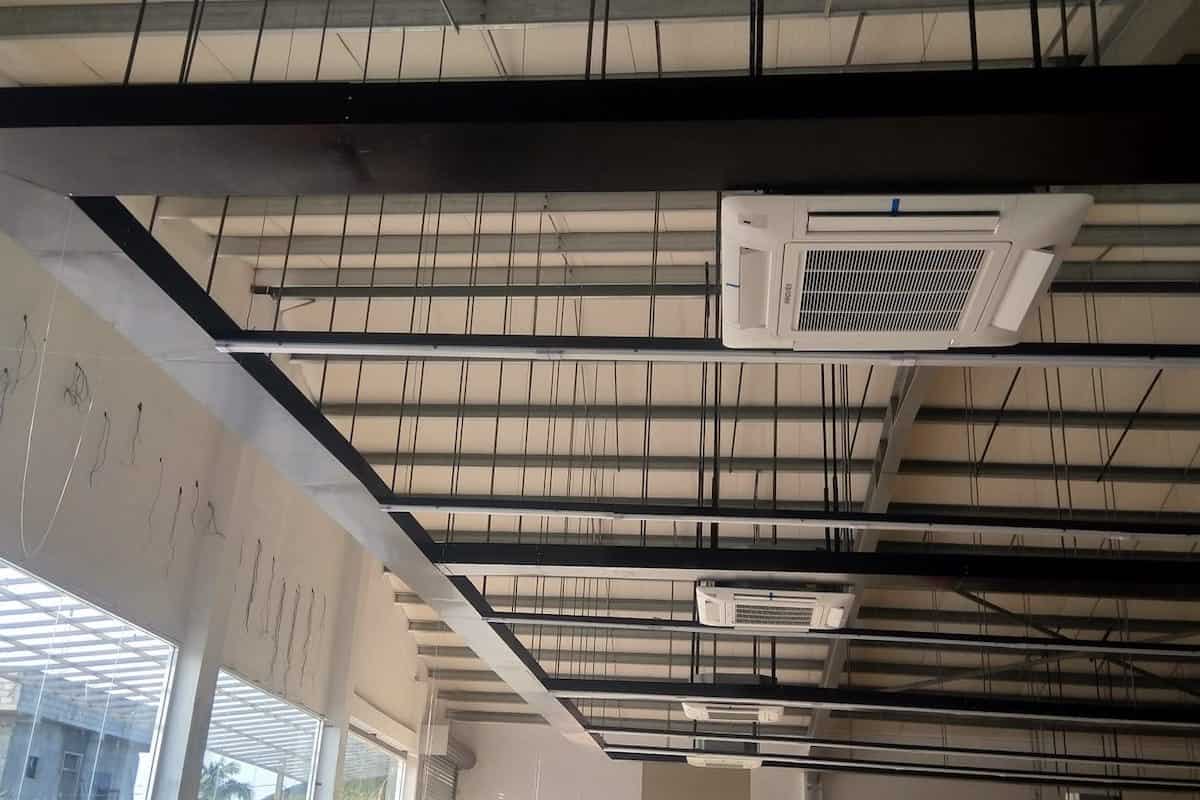
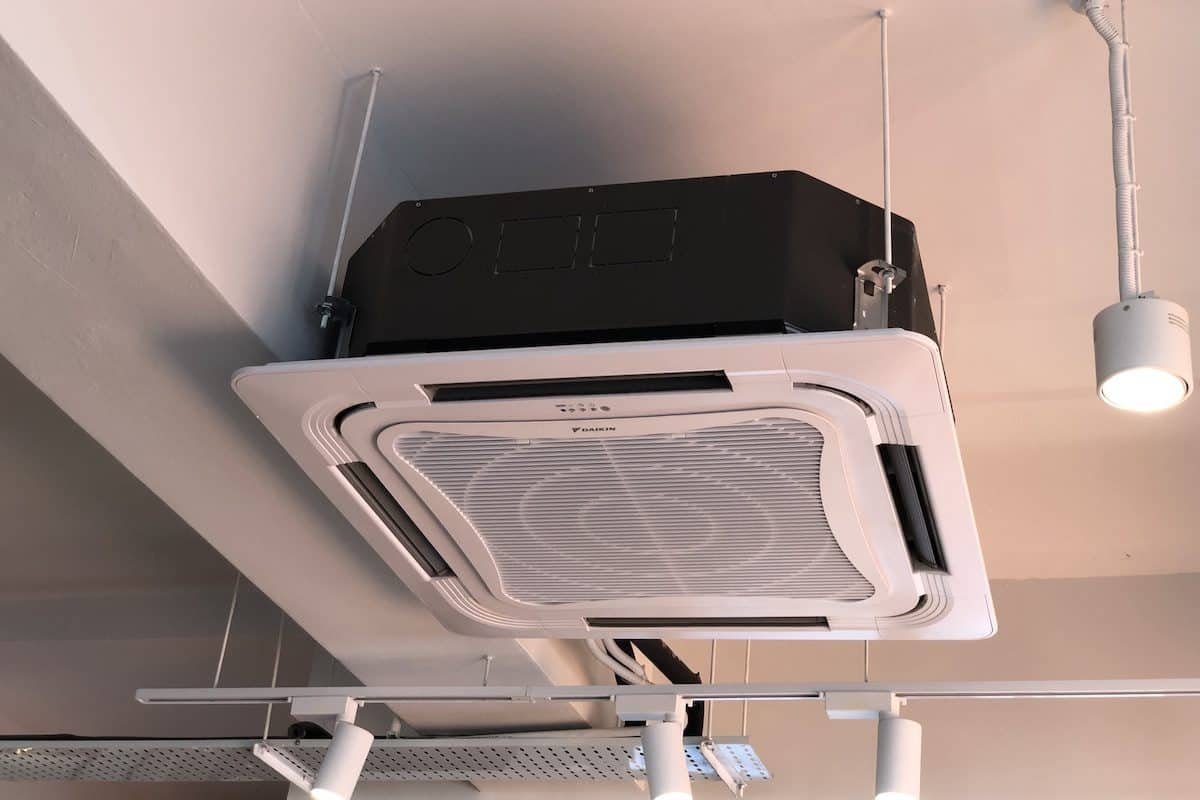
See my post Most Efficient Mini Splits: Cooling, Heating & Different Types to find out which ceiling cassette mini splits have the highest heating and cooling efficiency.
2. Floor Mounted Mini Split
If your sunroom doesn’t have full-height windows, you may consider using a floor-mounted type of ductless mini split heat pump. However, if your sunroom does have full-height windows, a floor-mounted unit will block a portion of the windows and it doesn’t look very nice.
3. Wall Mounted Mini Split
If your sunroom is not full of windows and there is space for you to put a wall-mounted mini split, you may consider it since it is simpler and cheaper. However, if a wall-mounted unit is positioned such that it blows air directly towards the hot windows, the total cooling effectiveness may drop.
Conclusion
Mini splits are very efficient and operate quietly. Hence, they are an excellent choice for cooling and heating a sunroom. However, the capacity of the mini split for sunrooms must be increased to compensate for the additional solar heat gain from all the sunroom windows.
In addition, a ceiling cassette type of ductless mini split heat pump is the best type of mini split for conservatory and solarium type of sunrooms. For sunrooms with fewer windows, a wall-mounted ductless mini split is a simpler way to cool and heat the sunroom.
Lastly, consider my Mini Split (eBook) if you want to know how can you use Mini Split in your house. If you still have doubt or not feeling confident enough, feel free to consult me.
Consultation Service
Ask me for HVAC advice such as brand selection, best model, benefits, features, placement, duct size, grille size, how to design, design check, verification and other HVAC related queries.
If you have anything to add (or ask) about this topic, leave a comment down below!


